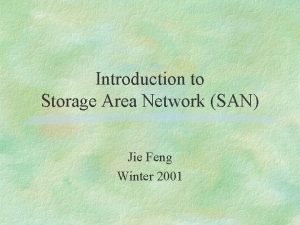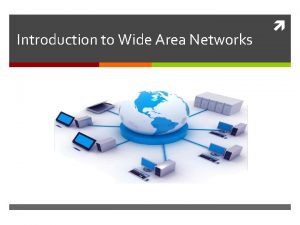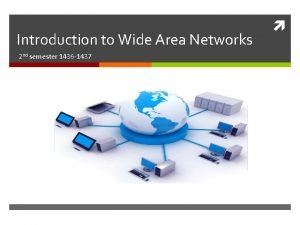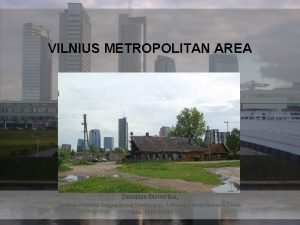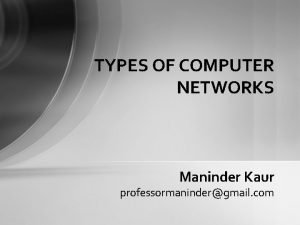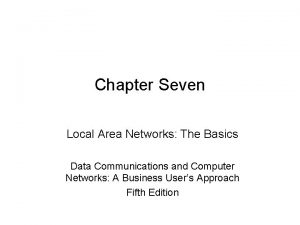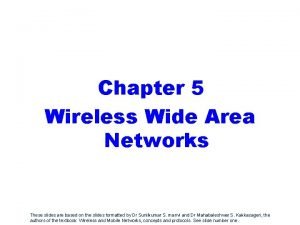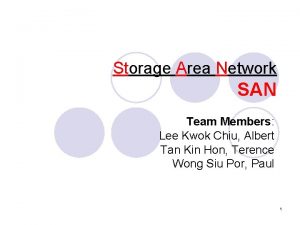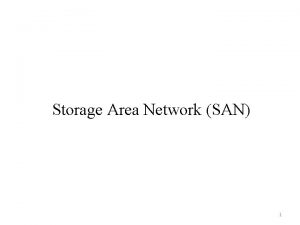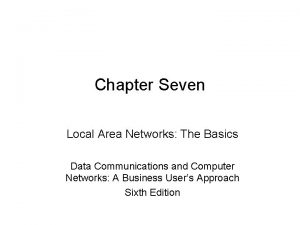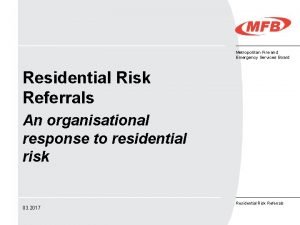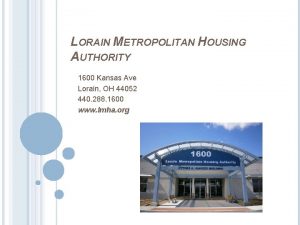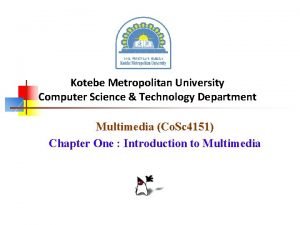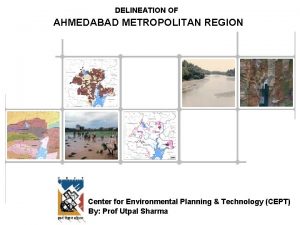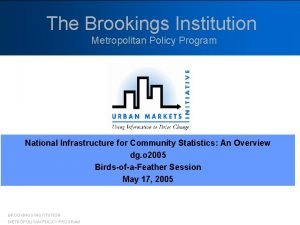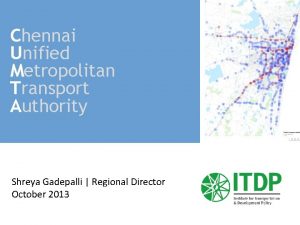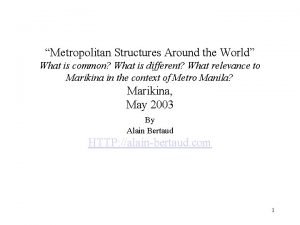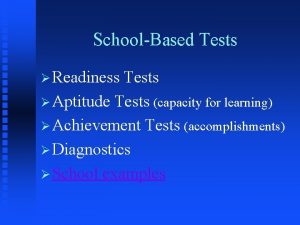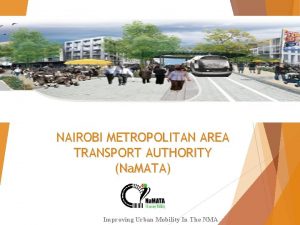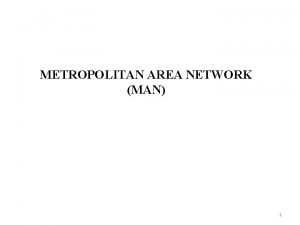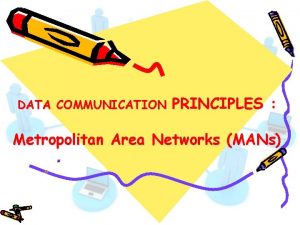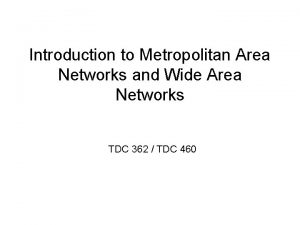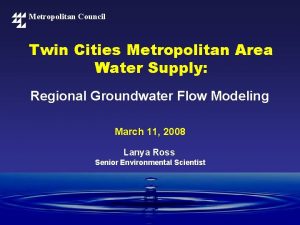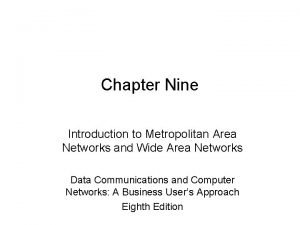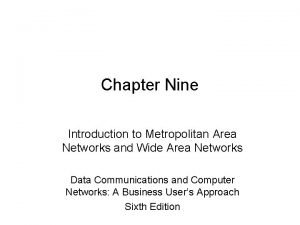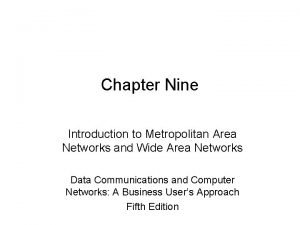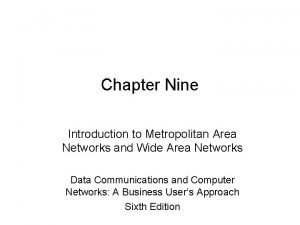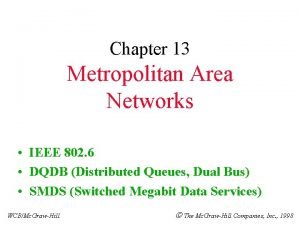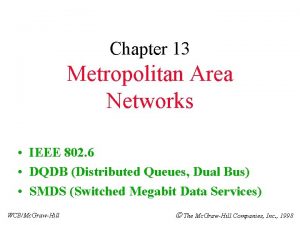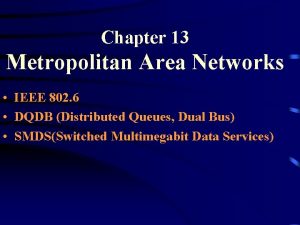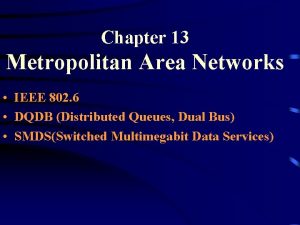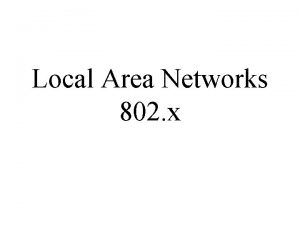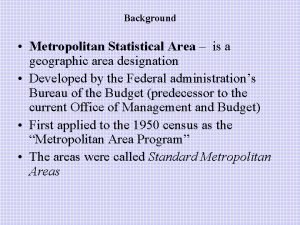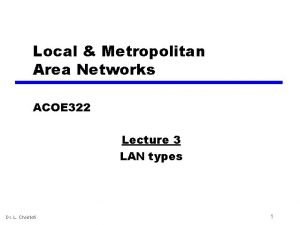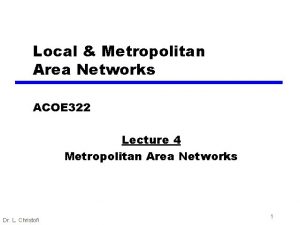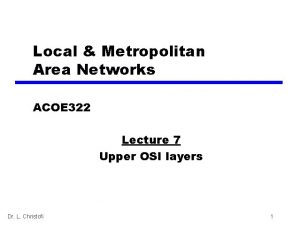Chapter 1 Introduction Metropolitan Area Networks A metropolitan





































- Slides: 37

Chapter 1 Introduction

Metropolitan Area Networks A metropolitan area network based on cable TV.

Wide Area Networks Relation between hosts on LANs and the subnet.

Wide Area Networks (2) A stream of packets from sender to receiver.

Wireless Networks Categories of wireless networks: • System interconnection • Wireless LANs • Wireless WANs

Wireless Networks (2) (a) Bluetooth configuration (b) Wireless LAN

Wireless Networks (3) (a) Individual mobile computers (b) A flying LAN

Home Network Categories • • • Computers (desktop PC, PDA, shared peripherals Entertainment (TV, DVD, VCR, camera, stereo, MP 3) Telecomm (telephone, cell phone, intercom, fax) Appliances (microwave, fridge, clock, furnace, airco) Telemetry (utility meter, burglar alarm, babycam).

Network Software • • • Protocol Hierarchies Design Issues for the Layers Connection-Oriented and Connectionless Service Primitives The Relationship of Services to Protocols

Network Software Protocol Hierarchies Layers, protocols, and interfaces.

Protocol Hierarchies (2) The philosopher-translator-secretary architecture.

Protocol Hierarchies (3) Example information flow supporting virtual communication in layer 5.

Connection-Oriented and Connectionless Services Six different types of service.

Service Primitives Five service primitives for implementing a simple connectionoriented service.

Service Primitives (2) Packets sent in a simple client-server interaction on a connection-oriented network.

Services to Protocols Relationship The relationship between a service and a protocol.

Reference Models • • • The OSI Reference Model The TCP/IP Reference Model A Comparison of OSI and TCP/IP A Critique of the OSI Model and Protocols A Critique of the TCP/IP Reference Model

OSI Reference model : The Open System Interconnection (OSI) Reference Model is a description for layered communications and computer network protocol design. It was developed as part of the Open Systems Interconnection (OSI) initiative. It divides network architecture into seven layers which are, from top to bottom, the Application, Presentation, Session, Transport, Network, Data-Link, and Physical Layers. It is therefore often referred to as the OSI Seven Layer Model. A layer is a collection of similar functions that provide services to the layer above it and receives service from the layer below it. On each layer an instance provides services to the instances at the layer above and requests service from the layer below.

Why do we need the OSI Model? To address the problem of networks increasing in size and in number, the International Organization for Standardization (ISO) researched many network schemes and recognized that there was a need to create a network model that would help network builders implement networks that could communicate and work together and therefore, released the OSI reference model in 1984. 19

OSI Reference Model Layer Function 7. Application Network process to application 6. Presentation Data representation and encryption 5. Session Host-to-host communication Segment 4. Transport End-to-end connections and reliability Packet 3. Network Path determination and logical addressing Frame 2. Data Link Physical addressing Bit 1. Physical Media, signal and binary transmission Data unit Data

Reference Models The OSI reference model.

Layer 7: Application Layer the application layer provides services for an application program to ensure that effective communication with another application program in a network is possible. It is a service layer that provides these services: • Allows applications to use the network. • Message authenticates either the message sender or receiver or both • Makes sure that necessary communication resources exist • Determines protocol and data syntax rules at the application level • Interface between the user & the computer (applications & Gateways). Provides services that directly support user applications, such as the USER INTERFACE, EMAIL, FILE TRANSFER, TERMINAL EMULATION, DATABASE ACCESS. • Handles Network access, flow control & error recovery. • Messages are sent between layers.

Layer 7 - The Application Layer 7 Application 6 Presentation 5 Session 4 Transport 3 Network 2 Data Link 1 Physical This layer deal with networking applications. Examples: Email Web browsers PDU - User Data

Layer 6: Presentation Layer The Presentation Layer enables translation between Application Layer entities, in which the higher-layer entities can use different syntax and semantics, as long as the Presentation Service understands both and the mapping between them. • This layer formats and encrypts data to be sent across a network. • The presentation service data units are then encapsulated into Session Protocol Data Units, and moved to the lower layers. • Translation of data into understandable format for transmission (into a form usable by the application layer i. e. translates data between the formats the network requires and the computer expects). • Handles character encoding, bit order and byte order issues. Encodes and decodes data. • Data compression and encryption takes place at this layer. • Generally determines the structure of data • The redirector works at this layer. • Responsible for protocol conversion

Layer 6 - The Presentation Layer 7 Application 6 Presentation 5 Session 4 Transport 3 Network 2 Data Link 1 Physical This layer is responsible for presenting the data in the required format which may include: Encryption Compression PDU - Formatted Data

Layer 5: Session Layer • The Session layer controls the dialogues (connections) between computers. It establishes, manages and terminates the connections between the local and remote application. It provides for full-duplex, half-duplex, or simplex operation. • Provides synchronization between communicating computers (nodes), messages are sent between layers (i. e. Manages upper layer errors). • Places checkpoints in the data flow, so that if transmission fails, only the data after the last checkpoint needs to be retransmitted.

Layer 5 - The Session Layer 7 Application 6 Presentation 5 Session 4 Transport This layer establishes, manages, and terminates sessions between two communicating hosts. 2 Data Link Example: Client Software ( Used for logging in) 1 Physical PDU - Formatted Data 3 Network

Layer 4: Transport Layer • The Transport Layer provides transparent transfer of data between end users, providing reliable data transfer services to the upper layers. • Responsible for PACKET HANDLING. Ensures error free delivery. Repackages messages, divides messages into smaller packets (Fragments and reassembles data), and handles error handling • Ensures proper sequencing and without loss and duplication. • Takes action to correct faulty transmissions • Controls flow of data • Acknowledges successful receipt of data • Sliding window is at this Layer -segments of message fragments are sent between layers • TCP - connection oriented communication for applications to ensure error free delivery. • UDP- connectionless communications and does not guarantee packet delivery between transfer points

Layer 4 - The Transport Layer 7 Application 6 Presentation 5 Session 4 Transport 3 Network 2 Data Link 1 Physical This layer breaks up the data from the sending host and then reassembles it in the receiver. It also is used to insure reliable data transport across the network. PDU - Segments

Layer 3: Network Layer The Network Layer provides the functional and procedural means of transferring variable length data sequences from a source to a destination via one or more networks. The Network Layer performs network routing functions, and might also perform fragmentation and reassembly, and report delivery errors. A well known example of the network layer protocol is the Internet Protocol (IP). Logical addressing - software addresses to hardware addresses are resolved (ARP/RARP). Determining the best route (Makes routing decisions & forwards packets. Layer 2: Data Link Layer The Data Link Layer provides the functional and procedural means to transfer data between network entities and to detect and correct errors that may occur in the Physical Layer Data link layer arrange bits, from the Physical Layer, into logical sequences called frames.

Layer 3 - The Network Layer 7 Application 6 Presentation 5 Session 4 Transport 3 Network 2 Data Link 1 Physical Sometimes referred to as the “Cisco Layer”. Makes “Best Path Determination” decisions based on logical addresses (usually IP addresses). PDU - Packets

Layer 2 - The Data Link Layer 7 Application 6 Presentation 5 Session 4 Transport 3 Network 2 Data Link 1 Physical This layer provides reliable transit of data across a physical link. Makes decisions based on physical addresses (usually MAC addresses). PDU - Frames

Layer 1: Physical Layer The Physical Layer defines the electrical and physical specifications for devices. This includes the layout of pins, voltages, cable specifications, Hubs, repeaters, network adapters, and more. The Physical Layer will tell one device how to transmit to the communication medium, and another device how to receive from it The major functions and services of the Physical Layer are: • Establishment and termination of a connection to a communications medium. • Flow control. • Modulation (conversion between the representation of digital data). These are signals operating over the physical cabling (such as copper and optical fiber) or over a radio link

Layer 1 - The Physical Layer 7 Application 6 Presentation 5 Session 4 Transport 3 Network 2 Data Link 1 Physical This is the physical media through which the data, represented as electronic signals, is sent from the source host to the destination host. Examples: CAT 5 (what we have) Coaxial (like cable TV) Fiber optic PDU - Bits

Host Layers 7 Application 6 Presentation 5 Session 4 Transport These layers only exist in the source and destination host computers. 3 Network 2 Data Link 1 Physical 35

Media Layers 7 Application 6 Presentation 5 Session 4 Transport 3 Network 2 Data Link 1 Physical These layers manage the information out in the LAN or WAN between the source and destination hosts. 36

The OSI Layers Communications 37
 Evolution of storage area network
Evolution of storage area network Introduction to wide area networks
Introduction to wide area networks Introduction to wide area networks
Introduction to wide area networks Donatas burneika
Donatas burneika Metropolitan area network
Metropolitan area network Metropolitan area
Metropolitan area Datagram switching vs virtual circuit
Datagram switching vs virtual circuit Backbone networks in computer networks
Backbone networks in computer networks What are the basic layouts of local area networks
What are the basic layouts of local area networks Wireless wide area network
Wireless wide area network Xp1024 storage
Xp1024 storage Storage area networks tutorial
Storage area networks tutorial San storage definition
San storage definition What are the basic layouts of local area networks
What are the basic layouts of local area networks Introduction to neural networks using matlab
Introduction to neural networks using matlab Introduction to communication networks
Introduction to communication networks Convolutional neural network
Convolutional neural network Xooutput
Xooutput Introduction to switched networks
Introduction to switched networks Metropolitan fire and emergency services board
Metropolitan fire and emergency services board Lorain housing authority
Lorain housing authority Kotebe metropolitan university computer science
Kotebe metropolitan university computer science Ahmedabad metropolitan region
Ahmedabad metropolitan region Metropolitan policy program
Metropolitan policy program Art lovers can visit the - metropolitan museum of art
Art lovers can visit the - metropolitan museum of art Habib metropolitan car finance
Habib metropolitan car finance Smha canton ohio
Smha canton ohio European metropolitan authorities
European metropolitan authorities Unified metropolitan transport authority
Unified metropolitan transport authority Metropolitan structures
Metropolitan structures Metropolitan bank
Metropolitan bank Helsinki
Helsinki Metropolitan design center
Metropolitan design center Boston university metropolitan college
Boston university metropolitan college Gorillagirls
Gorillagirls Jade patton
Jade patton Gesell developmental checklist
Gesell developmental checklist Nairobi metropolitan transport authority
Nairobi metropolitan transport authority
